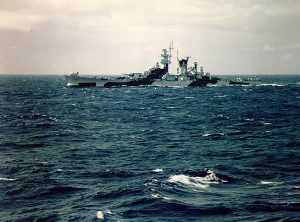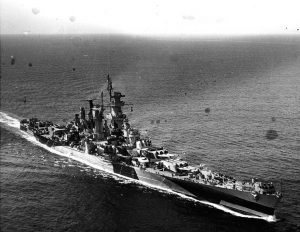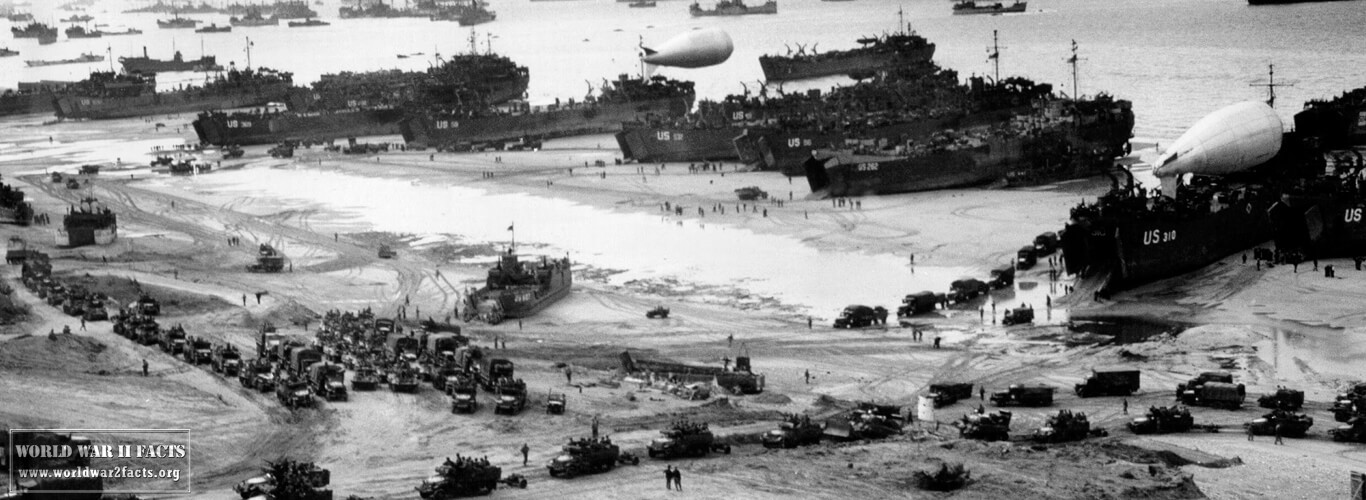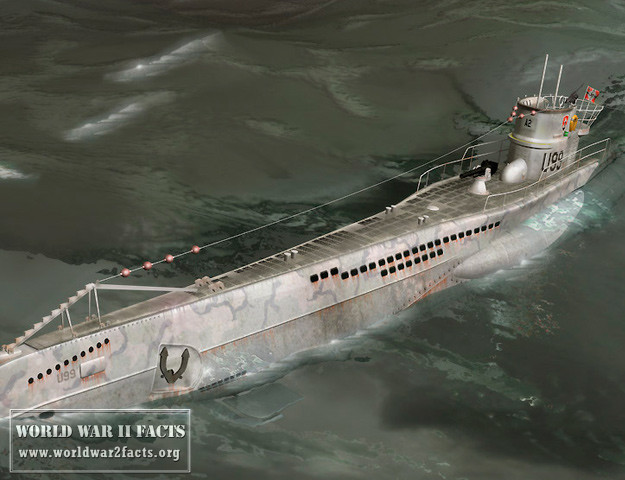USS Alaska (CB-1)
 Group shot of USS Alaska crew
Group shot of USS Alaska crewThe USS Alaska (CB-1), was the first ship in the Alaska class of large cruisers that saw service for the United States Navy during World War 2. The Alaska would be the first of two ships of the class to be completed prior to the end of WW2. The second ship in the Alaska class was the Guam with the remaining four hulls planned not seeing completion prior to the Japanese surrender. At the time of commissioning, the Alaska was the third ship in the United States Navy’s history to be named after the territory of Alaska. The ship’s keel was laid on December 17th, 1941 and was launched in August of 1943 in Camden, New Jersey at the New York Shipbuilding Corporation. Alaska would be commissioned in June of 1944 and feature a main batter of nine, 12 inch guns located in three triple turrets. The ship featured a top speed of 33 knots and would earn three battle stars during World War 2.
USS Alaska Ship Information
Contents
Namesake: Alaska
Ordered: 9 September 1940
Builder: New York Shipbuilding Corporation

Yard number: Contract 435
Way number: L
Laid down: 17 December 1941
Launched: 15 August 1943
Sponsored by: Mrs. Ernest Gruening
Commissioned: 17 June 1944
Decommissioned: 17 February 1947
Struck: 1 June 1960
Honors and awards: Three World War 2 battle stars
Fate: Scrapped in 1960
USS Alaska Ship Characteristics
Displacement: Standard: 29,779 long tons (30,257 t)
Full load: 34,253 long tons (34,803 t)
Length: 808 ft 6 in (246.4 m)
Beam: 91 ft 1 in (27.8 m)
Draft: 31 ft 10 in (9.7 m)
Installed power: 153,000 shp (114,000 kW)
Propulsion: General Electric steam turbines
8 Babcock & Wilcox boilers
4 shafts
Speed: 33 knots
Range: 12,000 nmi (22,000 km; 14,000 mi) at 15 knots (28 km/h; 17 mph)
Crew: 1,517
Armament: 9 × 12″/50 caliber (305 mm),
12 × 5 in (127 mm) guns
56 × 40 mm (1.6 in) guns
34 × 20 mm (0.79 in) guns
Armor: Belt: 9 in (229 mm)
Turrets: 12.8 in (325 mm)
Deck: 4 in (102 mm)
Aircraft carried: 4
USS Alaska Video
Building the USS Alaska
The USS Alaska was authorized to be built under the United States’ Fleet Expansion Act on July 19th, 1940. The ship was officially ordered by the USN on September 9th, 1940, and keel was laid down 10 days after the attack on Pearl Harbor on December 19th, 1941 in Camden, New Jersey at the New York Shipbuilding Company. Alaska would be launched on August 15th, 1943 and was sponsored by the spouse of the Alaska governor at the time. The ship was completed in June 1944 and commissioned on June 17th with Captain Peter K. Fischler in command. Featuring four shafts and a cruising range of 12,000 nautical miles, the cruiser also carrier four OS2U Kingfisher or SC Seahawk seaplanes that used two steam catapults for launch located amidships on the Alaska’s superstructure.
USS Alaska Service in World War 2
The USS Alaska departed California for Hawaii on January 8th, 1945. After arrival on January 13th, the ship participated in additional training and was assigned to Task Group 12.2 that left the islands for Ulithi on January 29th, 1945. After arrival on February 6th, 1945, the Task Group was combined into Task Group 58.5 which was a sub-component of the much larger Task Force 58, Fast Carrier Task Force. Task Group 58.5 was responsible for anti-aircraft defense for the aircraft carriers. The Alaska was assigned to defend the Saratoga and the Enterprise.
Task Force 58 sailed to conduct offensive operations against the Japanese mainland on February 10th to conduct strike operations against Tokyo and the airfields surrounding the city. After the operation was completed, the Alaska was transferred to Task Group 58.4 and supported the USMC during the Battle of Iwo Jima. Alaska served as a screen for the carriers supporting the Battle of Iwo Jima for a 19 day time-frame and departed station to refuel and resupply in Ulithi.
During the Battle of Okinawa, the USS Alaska remained assigned to TG 58.4 and was assigned to screen the Intrepid and Yorktown.

Departing Ulithi on March 14th, 1945, the first strikes against Okinawa began four days later. During the battle, the Japanese would launch a major air strike against the U.S. Naval Fleet. During the attack, the Alaska destroyed a Yokosuka P1Y bomber attempting to crash in the carrier, Intrepid. The ship gunners would shoot down a second Japanese bomber, a Yokosuka D4Y later on the same day.
After the U.S. carrier Fanklin suffered damage from several Japanese bombing runs and a kamikaze attack, the Alaska and Guam along with a number of destroyers were detached from the force main body to form Task Group 58.2.9 to escort the damaged carrier back to Ulithi. During the voyage, the force was attacked by another Japanese D4Y bomber. Although unsuccessful at shooting the plane down, there were several sailors on Alaska that suffered flash burns from the ship’s 5inch guns. These would prove to be the only casualties suffered by ship’s company onboard the ship during WW2. After this attack, the Alaska used the installed anti-air search radar to vector U.S. fighters to successfully intercept and destroy a Kawasaki Ki-45 heavy fighter. Once the ships reached Ulithi on March 22nd, 1945, the Alaska was detached to rejoin TG 58.4 off of Okinawa.
On March 27th, 1945, the Alaska and the Guam along with Destroyer Squadron 47 and other light cruisers were detached to conduct a bombardment of Minamidaitō. On March 27-28, 1945, the Alaska would shoot 45 12 inch shells and 352 5 inch rounds at targets on Okinawa. After refueling, the ship returned to support landings on Okinawa and would shoot down one enemy aircraft and assisted with another. On April 16th, 1945, the Alaska shot down three additional aircraft and assisted with the downing of three more. Over the remainder of April, the Alaska would help in driving off numerous Japanese bombers.
The ship would return to Ulithi on May 14th, 1945 and be assigned to TG 38.4 which was the reorganized carrier task force. The fleet returned to Okinawa and on June 9th, 1945 the Alaska and Guam bombarded targets on Oki Daitō. The Task Group would then sail to San Pedro Bay in Leyte Gulf for refit and maintenance where the Alaska remained from June 13th to July 13th. The ship was then assigned to Cruiser Task Force 95 with Guam under command of Rear Admiral Francis S. Low. The two cruisers would then conduct a sweep into the Yellow and East China Seas to sink Japanese shipping. After seeing limited success, the ships returned to the Task Force on July 23rd where they took part in a major raid up the Yangtze River off of Shanghai along with three battleships and three escort carriers.
USS Alaska after the War
On August 30th, 1945, the Alaska departed Okinawa for Japan to take part in the U.S. 7th Fleet occupation force. The ship arrived in Incheon, Korea on September 8th, 1945 and supported U.S. Army operations until September 26th, 1945 when the ship left for Tsingtao, China on the following day. The Alaska supported the U.S. 6th Marine Division until November 13th, 1945 when she was ordered to return to Incheon for transport of U.S. Army soldiers as part of Operation Magic Carpet. Once the ship offloaded the soldiers in San Francisco, she was ordered to the Atlantic and crossed the Panama Canal on December 13th, 1945 and arrived in the Boston Navy Yard on December 18th. On February 1st, 1946 the Alaska departed Boston for Bayonne, New Jersey to be berthed in the navy reserve. The Alaska was removed from active service on August 13th, and decommissioned on February 17th, 1947.
In 1958, the U.S. Bureau of Ships conducted two feasibility studies to see if both the Alaska and Guam were suitable to be converted to guided missile cruisers. Each study was considered to be too costly, and the conversion proposal was abandoned. The Alaska was subsequently stricken from the U.S. Naval Registry on June 1st, 1960 and sold to the Lipsett Division of Luria Brothers for scrap on June 30th, 1960.
USS Alaska References
Naval Historical Society, USS Alaska, Last retrieved 24 March 2013.
Naval Source Ship Archives, USS Alaska, last retrieved 24 March 2013.
USS Alaska (CB-1) Reunion website, Last retrieved 24 March 2013.




